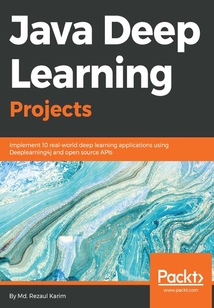舉報 

會員
Java Deep Learning Projects
Ifyouareadatascientist,machinelearningprofessional,ordeeplearningpractitionerkeentoexpandyourknowledgebydelvingintothepracticalaspectsofdeeplearningwithJava,thenthisbookiswhatyouneed!Getreadytobuildadvanceddeeplearningmodelstocarryoutcomplexnumericalcomputations.SomebasicunderstandingofmachinelearningconceptsandaworkingknowledgeofJavaarerequired.
目錄(241章)
倒序
- 封面
- 版權信息
- Packt Upsell
- Why subscribe?
- PacktPub.com
- Contributors
- About the author
- About the reviewer
- Packt is searching for authors like you
- Preface
- Who this book is for
- What this book covers
- To get the most out of this book
- Download the example code files
- Download the color images
- Conventions used
- Get in touch
- Reviews
- Getting Started with Deep Learning
- A soft introduction to ML
- Working principles of ML algorithms
- Supervised learning
- Unsupervised learning
- Reinforcement learning
- Putting ML tasks altogether
- Delving into deep learning
- How did DL take ML into next level?
- Artificial Neural Networks
- Biological neurons
- A brief history of ANNs
- How does an ANN learn?
- ANNs and the backpropagation algorithm
- Forward and backward passes
- Weights and biases
- Weight optimization
- Activation functions
- Neural network architectures
- Deep neural networks
- Multilayer Perceptron
- Deep belief networks
- Autoencoders
- Convolutional neural networks
- Recurrent neural networks
- Emergent architectures
- Residual neural networks
- Generative adversarial networks
- Capsule networks
- DL frameworks and cloud platforms
- Deep learning frameworks
- Cloud-based platforms for DL
- Deep learning from a disaster – Titanic survival prediction
- Problem description
- Configuring the programming environment
- Feature engineering and input dataset preparation
- Training MLP classifier
- Evaluating the MLP classifier
- Frequently asked questions (FAQs)
- Summary
- Answers to FAQs
- Cancer Types Prediction Using Recurrent Type Networks
- Deep learning in cancer genomics
- Cancer genomics dataset description
- Preparing programming environment
- Titanic survival revisited with DL4J
- Multilayer perceptron network construction
- Hidden layer 1
- Hidden layer 2
- Output layer
- Network training
- Evaluating the model
- Cancer type prediction using an LSTM network
- Dataset preparation for training
- Recurrent and LSTM networks
- Dataset preparation
- LSTM network construction
- Network training
- Evaluating the model
- Frequently asked questions (FAQs)
- Summary
- Answers to questions
- Multi-Label Image Classification Using Convolutional Neural Networks
- Image classification and drawbacks of DNNs
- CNN architecture
- Convolutional operations
- Pooling and padding operations
- Fully connected layer (dense layer)
- Multi-label image classification using CNNs
- Problem description
- Description of the dataset
- Removing invalid images
- Workflow of the overall project
- Image preprocessing
- Extracting image metadata
- Image feature extraction
- Preparing the ND4J dataset
- Training evaluating and saving the trained CNN models
- Network construction
- Scoring the model
- Submission file generation
- Wrapping everything up by executing the main() method
- Frequently asked questions (FAQs)
- Summary
- Answers to questions
- Sentiment Analysis Using Word2Vec and LSTM Network
- Sentiment analysis is a challenging task
- Using Word2Vec for neural word embeddings
- Datasets and pre-trained model description
- Large Movie Review dataset for training and testing
- Folder structure of the dataset
- Description of the sentiment labeled dataset
- Word2Vec pre-trained model
- Sentiment analysis using Word2Vec and LSTM
- Preparing the train and test set using the Word2Vec model
- Network construction training and saving the model
- Restoring the trained model and evaluating it on the test set
- Making predictions on sample review texts
- Frequently asked questions (FAQs)
- Summary
- Answers to questions
- Transfer Learning for Image Classification
- Image classification with pretrained VGG16
- DL4J and transfer learning
- Developing an image classifier using transfer learning
- Dataset collection and description
- Architecture choice and adoption
- Train and test set preparation
- Network training and evaluation
- Restoring the trained model and inferencing
- Making simple inferencing
- Frequently asked questions (FAQs)
- Summary
- Answers to questions
- Real-Time Object Detection using YOLO JavaCV and DL4J
- Object detection from images and videos
- Object classification localization and detection
- Convolutional Sliding Window (CSW)
- Object detection from videos
- You Only Look Once (YOLO)
- Developing a real-time object detection project
- Step 1 – Loading a pre-trained YOLO model
- Step 2 – Generating frames from video clips
- Step 3 – Feeding generated frames into Tiny YOLO model
- Step 4 – Object detection from image frames
- Step 5 – Non-max suppression in case of more than one bounding box
- Step 6 – wrapping up everything and running the application
- Frequently asked questions (FAQs)
- Summary
- Answers to questions
- Stock Price Prediction Using LSTM Network
- State-of-the-art automated stock trading
- Developing a stock price predictive model
- Data collection and exploratory analysis
- Preparing the training and test sets
- LSTM network construction
- Network training and saving the trained model
- Restoring the saved model for inferencing
- Evaluating the model
- Frequently asked questions (FAQs)
- Summary
- Answers to questions
- Distributed Deep Learning – Video Classification Using Convolutional LSTM Networks
- Distributed deep learning across multiple GPUs
- Distributed training on GPUs with DL4J
- Video classification using convolutional – LSTM
- UCF101 – action recognition dataset
- Preprocessing and feature engineering
- Solving the encoding problem
- Data processing workflow
- Simple UI for checking video frames
- Preparing training and test sets
- Network creation and training
- Performance evaluation
- Distributed training on AWS deep learning AMI 9.0
- Frequently asked questions (FAQs)
- Summary
- Answers to questions
- Playing GridWorld Game Using Deep Reinforcement Learning
- Notation policy and utility for RL
- Notations in reinforcement learning
- Policy
- Utility
- Neural Q-learning
- Introduction to QLearning
- Neural networks as a Q-function
- Developing a GridWorld game using a deep Q-network
- Generating the grid
- Calculating agent and goal positions
- Calculating the action mask
- Providing guidance action
- Calculating the reward
- Flattening input for the input layer
- Network construction and training
- Playing the GridWorld game
- Frequently asked questions (FAQs)
- Summary
- Answers to questions
- Developing Movie Recommendation Systems Using Factorization Machines
- Recommendation systems
- Recommendation approaches
- Collaborative filtering approaches
- Content-based filtering approaches
- Hybrid recommender systems
- Model-based collaborative filtering
- The utility matrix
- The cold-start problem in collaborative-filtering approaches
- Factorization machines in recommender systems
- Developing a movie recommender system using FMs
- Dataset description and exploratory analysis
- Movie rating prediction
- Converting the dataset into LibFM format
- Training and test set preparation
- Movie rating prediction
- Which one makes more sense ;– ranking or rating?
- Frequently asked questions (FAQs)
- Summary
- Answers to questions
- Discussion Current Trends and Outlook
- Discussion and outlook
- Discussion on the completed projects
- Titanic survival prediction using MLP and LSTM networks
- Cancer type prediction using recurrent type networks
- Image classification using convolutional neural networks
- Sentiment analysis using Word2Vec and the LSTM network
- Image classification using transfer learning
- Real-time object detection using YOLO JavaCV and DL4J
- Stock price prediction using LSTM network
- Distributed deep learning – video classification using a convolutional-LSTM network
- Using deep reinforcement learning for GridWorld
- Movie recommender system using factorization machines
- Current trends and outlook
- Current trends
- Outlook on emergent DL architectures
- Residual neural networks
- GANs
- Capsule networks (CapsNet)
- Semantic image segmentation
- Deep learning for clustering analysis
- Frequently asked questions (FAQs)
- Answers to questions
- Other Books You May Enjoy
- Leave a review - let other readers know what you think 更新時間:2021-06-18 19:08:39
推薦閱讀
- OpenStack for Architects
- 極簡AI入門:一本書讀懂人工智能思維與應用
- 自動檢測與轉換技術
- 計算機圖形圖像處理:Photoshop CS3
- Implementing Splunk 7(Third Edition)
- 工業機器人應用案例集錦
- 工業機器人維護與保養
- Microsoft System Center Confi guration Manager
- 從零開始學C++
- 人工智能技術入門
- R Data Analysis Projects
- 計算機組成與操作系統
- Cloudera Hadoop大數據平臺實戰指南
- Kubernetes on AWS
- 項目實踐精解:C#核心技術應用開發
- Java Deep Learning Projects
- 工業機器人基礎
- 傳感器與檢測技術
- Learning VMware App Volumes
- OpenGL Development Cookbook
- R Programming By Example
- 工業自動化儀器儀表與裝置修理工
- Network Security with pfSense
- Mastering PostGIS
- 網絡硬件搭建與配置實踐
- Spark海量數據處理:技術詳解與平臺實戰
- 機器學習算法實踐:推薦系統的協同過濾理論及其應用
- 機器學習案例實戰
- Puppet for Containerization
- 獨辟蹊徑品內核

